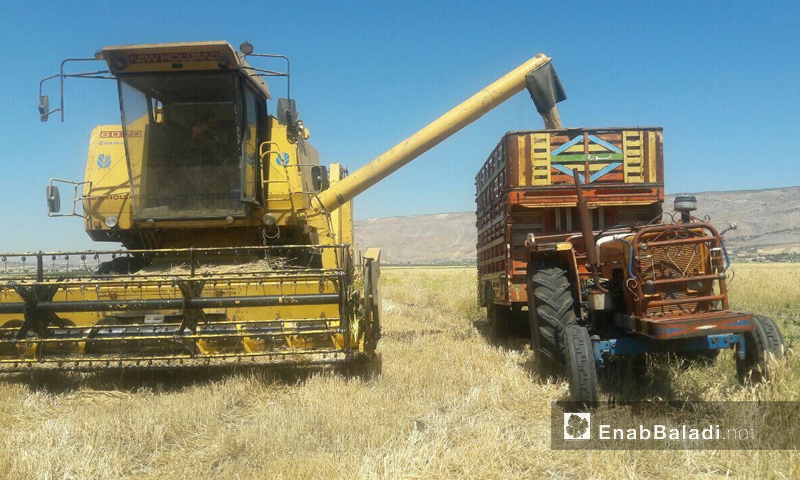



The year of 2018 has witnessed a rain delay and scarcity, especially at the beginning of the agricultural season, which contributed to the deterioration of strategic crops’ production, on top of which is wheat.
The area of al-Ghab Plain is a major source for the Syrian wheat due to its fertile soil, considered among the most fertile types of soil in the Middle East, that is distinct for its sedimentary nature, similar to the lands adjoining the two rivers of Euphrates and the Khabur.
The soil’s fertile nature turned it into a suitable environment for cultivating several strategic crops, including cotton, sugar beet, sunflower and different types of cereals and vegetables.
Ibrahim Ramadan, a farmer in the al-Ghab Plain, owns a wheat field, on which he counts this year as he told Enab Baladi, like many of the rest of the farmers who pin great hopes on this year’s season as a result of the last season’s abundance.
“Each acre costed more than 15 thousand Syrian pounds, while each acre’s production is no more than 250 thousand kilograms, hinting that the season’s production was not proportionate with the its cost,” Ramadan said.
He added that the organizations concerned with the agricultural affairs did not present the required support needed for growing wheat in the al-Ghab Plain area.
Jamal al-Fawaz, the head of the Agricultural Extension Department in the town of “al-Hwaiz,” attributed this year’s wheat season’s deterioration to two reasons; the lacking rainfall and the diseases that affected wheat.
Al-Fawaz explained to Enab Baladi that rain was scarce in the first month, November, following the wheat planting process, in addition to its very short duration, pointing out that “wheat is a winter-based crop and needs massive amounts of rain, which led to proliferation of diseases, especially fungal ones.”
High humidity at night and equally massive heat at day led to the rust disease, which plays a major role in the deterioration of the wheat production, as it starts with the leaves reaching the pods; it causes the wheat seed to shrink and be light in terms of weight, and sometimes it empties the wheat stalks.
Al-Fawaz believes that the intermittent rains, especially that fell during the wheat blossoming period, has damaged the blossoms. The stems used to be straight up, following the rain, they became heavily slanted, though the stalks did not carry any pods yet. “A kind of pest, called Suni, has also contributed to the decrease in the wheat production due to the farmers’ failure to combat those insects with required pesticides and the institutions, due to the organizations and institutions’ lacking support in terms of fertilizers needed for growing wheat.”
Jihad Salameh, an agricultural engineer, agreed to the farmers viewpoint, for he also attributes the decline in the wheat production to the scarce rains, telling Enab Baladi about an additional reason which is the absence of alternative watering sources since the water in the dams has run out.
Salameh explained that “late rains, which fell densely in corresponded with the season’s arrival at the harvest phase, hit the crop with different diseases such as spots, bunt and powdery mildew, which affected northern Syria’s wheat reservoir.”
According to Enab Baladi’s interviews with the area’s farmers, the present crop’s productivity is below 300 kilograms per acre in many of western Hama’s towns.
Al-Fawaz backed these interviews with accurate statistics, saying that the wheat planted area has reached 10 thousand acres. Last year’s wheat production, per acre, ranged between 700 to 800 kilograms, while, this year, the per acre production has not exceeded 400 kilograms. Al-Ghap Plain has, in general, produced 250 thousand tons of wheat for 2017, this year’s production would not rise above 100 thousand tons, despite the fact that al-Ghab Plain’s wheat production used to form almost the third of Syria’s production.
The farmers start harvesting wheat in summer, but in al-Ghab Plain they start in spring, for some farmers specialize in producing “Freekeh,” which requires that the used wheat be green, moist and not yet dry. The farmers, to make it, burn the stalks and then sift them. Al-Ghab Plain is a major source for “Freekeh” that is usually sold for higher prices than those of other wheat products, such as flour and bulgur.
Al-Ghab Plain is the second Syrian major source of wheat, after al-Hasakah governorate, a fact that demands the concerned farmers foundations’ intervention to save the upcoming seasons, especially in relation to eliminating diseases.
if you think the article contain wrong information or you have additional details Send Correction